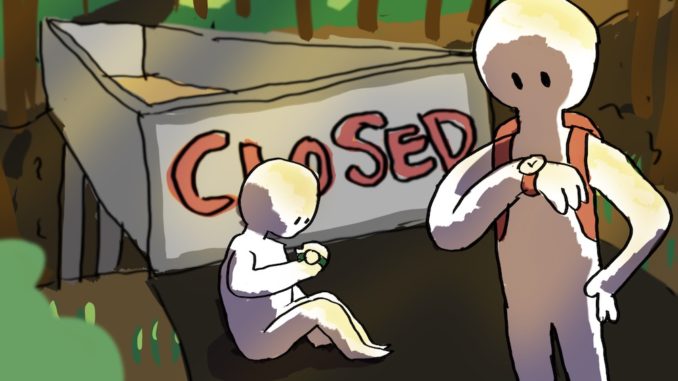
By Nick Sabatini
In previous years, students living on Lewis & Clark campus could access the academic buildings by crossing the bridges that span the ravine. However, this year, LC students must circumvent the ravine by passing under Templeton. Both bridges have been barricaded this year because the support structures were deteriorating.
“The bridges are closed because we were going to do some temporary repairs this summer,” Associate Vice President for Facilities Michel George said. “We noticed some rot down at the bottom, so we did some structural analysis reports. Structural engineers took a look, and as we started going in, we found that not only was there rot at the bottom, there was rot internally in both bridges.”
He said that the rot is a type of fungus that attacks the wood’s cells. As a result, the structural integrity of the wood was compromised, but there is no way of knowing how much. The structural engineer recommended that the bridges should be closed and replaced.
George said that although the bridges probably won’t collapse, there could be issues if the bridges are left open because there are many weak points that could break.
Meanwhile, students have been frustrated by the closure.
“I’m not a fan of it personally,” Bryan Miller ’20 said. He resides in Platt-Howard, a residence hall near the Howard bridge. “My knee has been acting up for unrelated reasons, and having to go uphill is just not ideal.”
Lark Wilson ’ 21, another Platt-Howard resident, is also not happy with the closure.
“I’m personally annoyed with the bridges. It’s frustrating to have to take longer routes to get to class. Most of the first years weren’t aware that it wouldn’t be open … the lack of communication … was annoying.”
Taisei Matsuo ’ 19 is a resident in Stewart that is not affected by the bridge closure. He has an opinion that differs from Miller’s and Wilson’s.
“There is no need to fix the bridges because of the cost,” said Matsuo. “Even though it creates more separation, it would be too expensive and not necessary. The bridges look nice because they are modern. There is no need to fix them, but it would be convenient for students if they were fixed.”
Miller understands that Facilities has a busy job, but he said it would be nice if they could prioritize fixing the bridges.
“I have some understanding of how difficult their day to day jobs are, but it would be greatly appreciated if they can make a priority out of fixing the bridge just because it really is like the lifeline from Platt-Howard to the academic side, and without it, it is kind of a mess,” he said.
Although students like Miller are frustrated about the closure, George said that they are working as fast as possible.
“We can’t go any faster,” George said. “We have to talk to the city because it is in an environmental zone. We have to negotiate with the city to get permits. The earliest we could get a meeting is (sic) October.”
According to George, the bridges were built in 1953 and wood bridges typically last 50 to 60 years.
“We spent the last few weeks doing soil tests and looking at different options,” George said. “We are hoping to start design in the next week or so on a new wood frame bridge that is locally manufactured and constructed. We hope to put footings in in October. We hope to put the bridge in late spring.”
The Howard bridge will be replaced, but the Templeton bridge will not be.
“We are talking about taking down the Templeton bridge,” George said. “It looks like it doesn’t serve much purpose apart from [Americans with Disabilities Act] because it is so short. Originally, when the dining facility was built in the 1950s, the ravine extended further. So, the bridge made sense because you had to go all the way around before. Since then, they put in the infill, so now the bridge is 20 feet away from the wall.”
On July 26, a four week construction program began to build a ramp underneath Templeton. The purpose of this ramp is to ensure the area stays ADA compliant in the absence of a bridge. This impacted foot traffic underneath Templeton.
George said that repairing the bridges was also considered, but the cost of repairing them would be almost the same as replacing them. The college discussed leaving the bridges open, but the structural engineer didn’t feel it was safe to do so.
The new bridge will be clear span, which means that there will be no support structures underneath. It will also be seismically stable and have a roof to protect the walkway from rain and overhead debris.
Although construction will begin in October, the new bridge is not projected to be complete until spring. Therefore, students living on campus must continue to use the path below Templeton to get to class.
Miller views the bridge issue from a figurative as well as a literal perspective.
“Bridges in general are a pretty powerful metaphor for togetherness, and a bridge being out is sort of an equally powerful metaphor for the opposite,” he said.
Subscribe to the Mossy Log Newsletter
Stay up to date with the goings-on at Lewis & Clark! Get the top stories or your favorite section delivered to your inbox whenever we release a new issue.

Leave a Reply